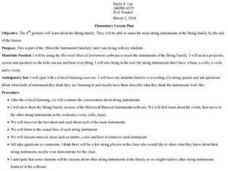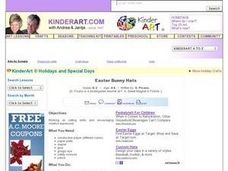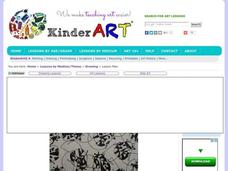National First Ladies' Library
Who Invented Crayons?
Pupils use a specified website to study the history of Crayola crayons. In groups, they discover who invented the colors, their cost, and who thought of the name. Learners create a timeline of Crayola colors and choose one project from...
Curated OER
Sadako and the Thousand Paper Cranes
Third graders explore their culture in comparison to Japanese culture by reading the book, Sadako and the Thousand Paper Cranes. They identify islands of Japan, create a Venn diagram comparing Japanese culture to American culture, and...
Curated OER
Invigorate and Inspire with Van Gogh's Bold Colors
Commemorate Van Gogh's birthday with colorful activities for all ages!
Berkshire Museum
Adopt a Schoolyard Tree
Help young scientists connect with nature and learn about trees with a fun life science lesson. Heading out into the school yard, children choose a tree to adopt, taking measurements, writing descriptions, and drawing sketches of it in...
Curated OER
Book Illustration
Students view a video and discuss what illustrations in a book show and don't show. In this observation instructional activity, students look at the details on a page in Alice in Wonderland and create an illustration.
Curated OER
I Am Special and You Are Special Too #5
The student create a drawing of themselves through the use of multicultural people color crayons. They explain to a teacher what makes them special. Young scholars investigate family types, skin color, eye color, hair color, and favorites.
Digital Forsyth
Photo Analysis for Visual Impact
A lesson on photo analysis, compare and contrast, and an art project are here for the taking. Fourth graders analyze photographs of gas stations from now and from the past, focusing on how the cars and building designs are a form of art....
Curated OER
"Painting" More Expressive Language
Students listen to the book Papa, Please Get The Moon For Me, by Eric Carle. They create an illustration using a computer paint program. Learners type one sentence describing their picture into a text box in the paint program to explain...
Curated OER
And Then What Happened?
Students analyze paintings by using verbs, adjectives, and nouns. In this visual arts lesson, students view a painting of a storm and a calm sky. Students use various verbs and adjectives to discuss the characteristics of each painting....
Curated OER
Oh Picasso!
Learners identify the painter Picasso as a famous Spanish cultural figure, name at least one of Picasso's painting styles and describe aspects of Picasso's Blue Period. They create their own Blue Period inspired work of art.
Curated OER
Descriptive Writing About a Picture
First graders word process a topic sentence, two detail sentences and a concluding sentence about an image. They import a picture and change the font color of their writing.
Curated OER
Indian Corn Pictures
Students examine Indian corn. In this autumn art instructional activity, students observe Indian corn, noting the different shades of color. Students sketch and color or paint an ear of Indian corn, adding actual corn kernels to outline...
Curated OER
Love Bug Bag
Students create "love bug bags" using pink pipe cleaners, construction paper, glue, glitter or sand, and a lunch sack in this Art lesson plan for the early-elementary classroom. This can be used in the Springtime or as a Valentine's Day...
Curated OER
Chinese Dragons
Students discover the world of the Chinese dragon by creating their own festive dragon using texture, line, shape, pattern, and color. This lesson is ideal for the early-elementary classroom and includes a recommened reading list.
Curated OER
Meet the Instrument Families
Fourth graders listen to a recording of a string quartet and ask questions about what kinds of instrument they think they are listening to and describe what they think the instruments look like. Then they discuss musical ideas such as...
Curated OER
Vincent's Flowers
Learners create sunflower paintings using pastels, pencils, and construction paper in this Art lesson for the early-elementary classroom. Emphasis is placed on the artwork of Vincent van Gogh and the book Camille and the Sunflowers by...
Curated OER
Bunny Hats
Students create "Bunny Hats" using construction paper, paper plates, glue, googly eyes, and pencils in this fun Art lesson for the early-elementary classroom. The lesson emphasizes building cutting skills and encouraging creative...
Curated OER
Clothespin Magnets
Students decorate letter, clothespin magnets using basic art supplies in this Art lesson plan for the elementary classroom. Teacher preparation should include cutting out letter shapes for each student and connecting clothespins prior...
Curated OER
Ceramic Tile Wall Murals
Students create multi-color lithographic posters, reinterpreting the technique of a famous artist or artistic style. They discuss art history, aesthetics, criticism, and personal expression. Students focus on the elements of design and...
Curated OER
Conflicts and Win-Win Solutions
Students examine the healthy ways to dealing with conflicts. In this conflict management lesson, students examine what problems lead to conflicts, and how to turn a situation into a win-win. The students utilize a conflict checklist in...
Curated OER
When a Chair is More than A Chair.....
Students research an artist of their choice and design a piece of art that represents that artist to them. They make sketches, plan their armature, cut out armature, pad with newspapers and apply layers of paper mach??.
Curated OER
Nature of Chagall - Oil Pastel Drawing - "I and the Village"
By studying the art and style of Marc Chagall, students create a surreal piece of art
representing themselves and their surroundings and illustrating Chagall's quote, "Great art picks up where nature ends".
Curated OER
Fighting Corrosion to Save an Ancient Greek Bronze
Study corrosion on bronze statues with a hands-on lesson plan. As pupils place a penny in water with salt, they observe the changes in the penny throughout a period of a week. They then analyze the pre-conservation and the...
Curated OER
Positive/Negative Bugs
Bugs can be creepy - and fun! Kids create a positive and negative design by repeatedly drawing a simple insect overlaid with a geometric shape. The outcome is really neat and will help build spacial reasoning, visual acuteness, and...

























